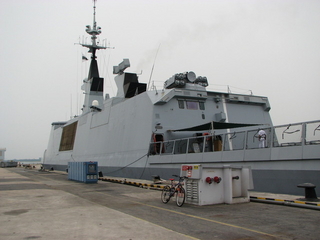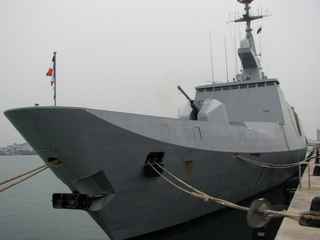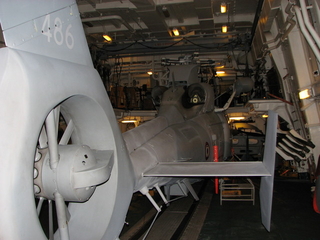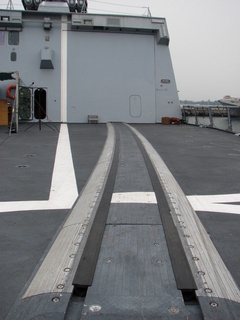By David Boey
30 September, 2006, Changi Naval Base, Singapore - The French Navy's stealth frigate La Fayette (F 710) got a close look at Singapore's Formidable-class stealth ships during her recent port call in Singapore.
La Fayette hosted a tour this morning for members of the Militarynuts discussion forum (http://militarynuts.com) while alongside at the Republic of Singapore Navy's (RSN) Changi Naval Base (CNB).
Her port call is significant because it marks the first time La Fayette joined the RSN's stealth ships at their base in Singapore. The naval facility is built on reclaimed land on the eastern end of Singapore island.
French and Singapore navy stealth ships
The RSN's six 114-metre long Formidable-class ships trace their design to the 125-metre La Fayette's hull form and superstructure. The Formidable ships, lead ship built by DCN in France and the rest by Singapore Technologies Marine in Singapore, are now in various stages of sea trials.
La Fayette is the smallest warship the Milnuts have visited - all the rest were aircraft carriers - but her status as big brother to the Formidable-class ships provided a rare chance to see firsthand the design philosophy that eventually led to the design of the RSN's latest surface combatants.
Though the Formidable-class is heavily modified and better armed, both warship classes are said to be difficult to detect using radar, electro-optic, acoustic and magnetic sensors - hence earning them the sexy moniker of stealth frigates.
The warship, named after a French nobleman who distinguished himself during the American independence struggle, lends her name to a class of five ships that serve with Marine Nationale.
La Fayette is based at the French Navy's base in Toulon, and has been on extended deployment to the eastern Mediterranean, Red Sea, Indian Ocean and the South China Sea. The ship has been away from home for some four months now.
Milnuts board the La Fayette
The Milnuts visit began with a briefing by the La Fayette's Operations Officer in the ship's wardroom.
La Fayette was launched in 1992 and turned fully operational in 1996, the 14-year old warship hardly shows her age. The crew displayed a high standard of ship husbandry and this is always a telling indicator of the pride the ship's company takes in maintaining their ship and ergo, the state of the ship's morale.
The wardroom was tastefully furnished, with wood panelling and polished parquet flooring giving it a warm and comfortable ambience.
The powerpoint briefing cover key milestone in the La Fayette's history, the design philosophy for the class of ships, missions and key performance data.
Stealth warship dissected
Due to the stealthy nature of the warships, the La Fayette's missions include tasks such as intelligence gathering and anti-surface hit-and-run attacks. Special forces can also be deployed from the ship and these can use a stern hatch under the flight deck to deploy rigid hull inflatable boats for ship-to-shore operations.
When detected on radar, the ship's radar echo is said to be similar to that of a small fishing ship or patrol boat.
Attention has also been paid to reducing its noise signature - a vital requirement for anti-submarine operations.
For instance, each of the four 5,220hp diesel engines sit on suspensions so vibrations for these powerplants are not transmitted to the hull (making her quiet and hard to detect by submarines). The hull is fitted with the Prairie Masker system which cloaks the hull with a layer of air bubbles to further reduce the noise transmitted from ship machinery even at full speed of 25 knots.
Topside, the ship has slanted hull sides and no right angles to reduce its radar image.
One can readily see such features in the outward appearance of the Formidable ships and logic dictates that design elements like Prairie Masker have also been included in the RSN's stealth ships.
The ship also opened its Combat Information Centre as part of the excursion - a rare privilege indeed. No photography was allowed, but the Ops Officer briefed us on the layout and functions of the crew members as they fight the naval war in four dimensions. These are anti-surface, anti-air, anti-submarine and in the electronic warfare (EW) realm.
La Fayette's sharp end comprises a 100mm main gun (with stealth cupola), eight MM 40 Exocet surface-to-surface missiles, eight Crotale surface-to-air missiles, two 20mm F2 cannon, an extensive EW suite and a Panther helicopter for over the horizon targetting. Thus armed, La Fayette can stay on patrol for 50 days.
It was on to La Fayette's bridge. Six crew members form a duty watch and this includes two lookouts, one port and starboard. It was interesting to learn that the bridge is an armoured citadel with positive pressure and air filters protecting the crew from nuclear, biological and chemical threats.
Again, it would not be far-fetched to believe the bridge of the Formidable-class is similarly protected.
After Kodak moments on the bridge were taken care of, we were guided to the La Fayette's engineering room. It is one of two places that operates the ship's electrical power, engine and water plants.
Three separate damage control stations - one in the bow, one midships and one aft - allow La Fayette's 150 crew to survive enemy attacks and continue fighting the ship.
The Milnuts were also show the passageway that lines both sides of the ship's hull. The idea is that this space serves as a sacrificial layer to protect crew compartments inside the ship, which is further protected by a armoured layer of high hardness steel.
La Fayette's naval aviation
The hangar and flight deck, which can take a 12-tonne chopper, were the last stops on the tour.
A Panther naval helicopter was inside the hangar. The Panther can be operated up to sea state 6, thanks to computer software that uses underwater stabilisers, two twin rudder and two propellors to counter the roll of the ship.
Incidentally, the hangar of the La Fayette is different from that on the RSN design. While the Singapore hangar follows the ship's centreline, the hangar on the La Fayette occupies the right half of the flight deck.
Going forward, La Fayette's Panthers due to be replaced by the NH 90 medium-heavy naval helicopter.
Our visit this morning is the first to a French man-of-war. Milnuts have previously toured the Indian Navy's Viraat aircraft carrier and several United States Navy ships, namely Abraham Lincoln, Ronald Reagan and Kitty Hawk.
By all accounts, the tour was a resounding success. We eagerly look forward to welcoming a French carrier to Singapore in early 2007.
Bon Voyage, La Fayette!
The Milnuts would like to thank the Embassy of the Republic of France, Marine Nationale and the RSN for making the educational visit possible.



